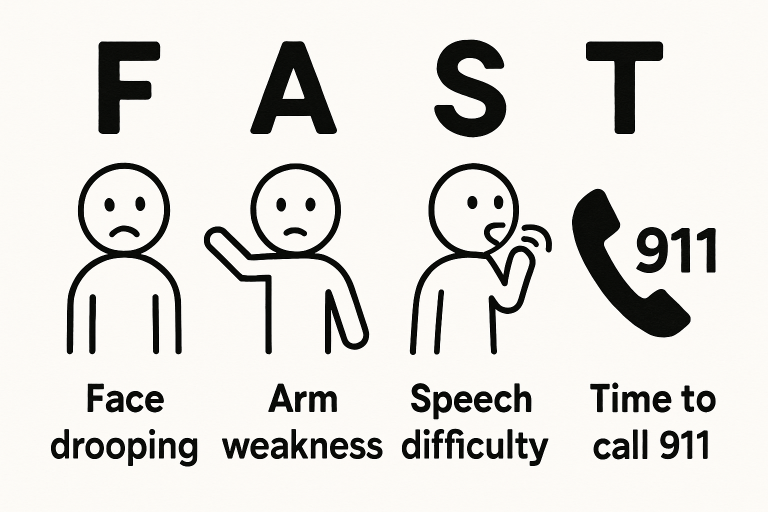The Urgency of Time in Stroke Care
Public awareness and system readiness are equally vital. Every second delays the delivery of essential treatments, potentially resulting in irreversible brain injury. Well-prepared medical teams and informed communities together can substantially impact stroke survival rates and quality of life outcomes.
When a stroke occurs, every minute counts. Faster treatment increases recovery chances and reduces disability or death risk. The CDC notes stroke is a leading U.S. killer, stressing quick, skilled intervention. Advances in therapies show that rapid diagnosis and action can preserve brain function and save lives. But when medical professionals fail to meet this urgent standard, the consequences can be devastating—cases related to stroke medical malpractice highlight just how important it is for both individuals and healthcare providers to recognize and react to symptoms without delay.
Recognizing the Signs: What Everyone Should Know
Recognizing stroke symptoms is critical for recovery. Warning signs include sudden numbness or weakness, especially on one side, confusion, trouble speaking or understanding speech, vision problems in one or both eyes, loss of balance, or a severe headache. The acronym FAST (Face drooping, Arm weakness, Speech difficulty, Time to call 911) can aid in rapid identification. Prompt medical attention is essential, as early intervention can restore blood flow to the brain, minimize damage, and improve rehabilitation outcomes.
Understanding Different Types of Strokes
Not all strokes are the same, and knowing the difference is crucial when seeking or delivering emergency care. Ischemic strokes, which account for about 87% of all strokes, occur when a blood clot blocks a vessel supplying blood to the brain. These are commonly treatable if addressed swiftly, often with medication that dissolves clots within the first hours of symptom onset. Hemorrhagic strokes, though less common, happen when a blood vessel ruptures, causing bleeding within the brain. This subtype often requires surgical intervention. Immediate action, regardless of stroke type, is vital to minimize brain damage and other complications.
Medical Interventions: What Happens in the ER?
Stroke patient care begins with immediate evaluation and brain imaging (CT or MRI) to determine stroke type and guide treatment. For ischemic strokes, timely administration of clot-busting medication (tPA) is crucial for restoring blood flow. Hemorrhagic strokes may require surgical intervention to control bleeding and reduce brain pressure. These rapid, protocol-driven interventions aim to minimize long-term disability and enhance recovery.
The Critical Role of Emergency Responders
First responders play a frontline role in improving stroke outcomes. They are trained to recognize stroke symptoms, prioritize high-speed transport, and alert hospitals ahead of patient arrival so teams are ready to act as soon as the patient enters. Research reported by the American Heart Association emphasizes that strong coordination between emergency services and hospitals is especially crucial for those in rural or underserved communities, where treatment delays often have more severe impacts.

Preventing Stroke: What You Can Do
To prevent strokes, it is crucial to manage chronic conditions such as diabetes, maintain a healthy diet, exercise regularly, avoid smoking, and limit alcohol intake. Public health authorities recommend regular medical checkups to monitor blood pressure, glucose, and cholesterol to reduce stroke risk and improve overall health.
Technology and Telemedicine in Stroke Care
Innovations in telemedicine have changed the landscape of stroke treatment, especially in communities where access to specialists is limited. With teleconsultations, even remote hospitals can connect instantly with stroke experts, obtain rapid input on diagnosis and treatment, and accelerate the administration of lifesaving therapies. This digital transformation is narrowing the survival gap between urban and rural patients, ensuring more people receive timely, expert care.
Ongoing Education and Community Involvement
Widespread, ongoing education is central to improving stroke outcomes. Schools, workplaces, and community organizations increasingly offer stroke identification and response training. Health organizations and advocacy groups run public awareness campaigns, providing toolkits and hosting events that empower individuals to act quickly when stroke symptoms occur. As more people learn to recognize and respond quickly to strokes, the overall burden of the disease is likely to decrease.
Conclusion: A Call to Be Prepared
Every second counts when someone is having a stroke. Timely action—recognizing warning signs, calling emergency services, and understanding that time is brain—saves lives and preserves quality of life. By staying informed and prepared, and advocating for effective systems and education in your community, you can help ensure that everyone has a better chance of recovery if a stroke strikes.
The Editorial Team at Healthcare Business Today is made up of experienced healthcare writers and editors, led by managing editor Daniel Casciato, who has over 25 years of experience in healthcare journalism. Since 1998, our team has delivered trusted, high-quality health and wellness content across numerous platforms.
Disclaimer: The content on this site is for general informational purposes only and is not intended as medical, legal, or financial advice. No content published here should be construed as a substitute for professional advice, diagnosis, or treatment. Always consult with a qualified healthcare or legal professional regarding your specific needs.
See our full disclaimer for more details.







